|
TATTOO DESIGNS & SYMBOLS - PLAYING CARD TATTOOS
Tattoo Symbol Index -
A
B
C
D
E
F
G
H
I
J
K
L
M
N
O
P
Q
R
S
T
U
V
W
X
Y
Z
Tattoo designs - P >>
Playing Cards
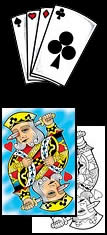 Playing
Card Tattoos - Playing cards are often featured in a
multitude of tattoo designs.
And the tattoo designs make full use of many of the symbols to be
found in a deck of cards, all the way from the Ace of Spades, to the
Queen of Hearts, to the 'wild' Joker. The modern pack of playing
cards can be traced back to Medieval Europe, when cards were a
dalliance of the rich. Printing techniques eventually made mass
production possible so that playing cards became popular with common
folk as well. A deck of cards consisted of 'royals' (also called
'court' cards), comprised of King, Queen and Knight (later termed
'Jack') - and number cards ranging from the 2 (deuce) to 10. The
Ace, which derived from the Latin for the 'smallest coinage', took
the lowest value of one. The four suits, Spades, Hearts, Diamonds
and Clubs (originally cups, swords, coins and batons) came in two
colours, red and black. In the 1500s, a pack became standardized to
the 52 cards we have today. Playing
Card Tattoos - Playing cards are often featured in a
multitude of tattoo designs.
And the tattoo designs make full use of many of the symbols to be
found in a deck of cards, all the way from the Ace of Spades, to the
Queen of Hearts, to the 'wild' Joker. The modern pack of playing
cards can be traced back to Medieval Europe, when cards were a
dalliance of the rich. Printing techniques eventually made mass
production possible so that playing cards became popular with common
folk as well. A deck of cards consisted of 'royals' (also called
'court' cards), comprised of King, Queen and Knight (later termed
'Jack') - and number cards ranging from the 2 (deuce) to 10. The
Ace, which derived from the Latin for the 'smallest coinage', took
the lowest value of one. The four suits, Spades, Hearts, Diamonds
and Clubs (originally cups, swords, coins and batons) came in two
colours, red and black. In the 1500s, a pack became standardized to
the 52 cards we have today.
|
|
The Spade was said to be the knight's spearhead. In some early decks
the leaf-like motif also stood for the aristocracy. The Heart was
symbol of the church, the Diamond stood for the wealthy, while the
Club was the clover or acorn, both representative of the peasant. In
England, these suits have held fast for more than five hundred
years. |
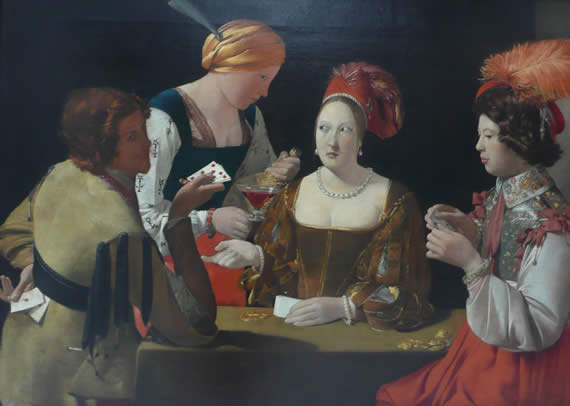
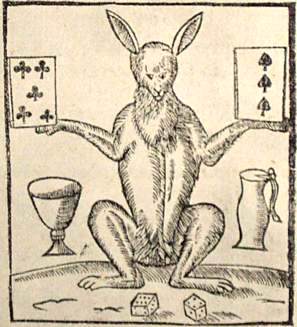 In France, the 'royals' -- the Kings and Courtiers -- were actually
identified on the card as historical personages, often according to
the whim of the card maker. The King of Spades was often identified
as King David, and the Knave of Spades was Hector of Troy. Other
contenders were Caesar as King of Diamonds, and Alexander as King of
Clubs. The identity of the Queens included saints like Saint Joan,
and Greek goddesses and various wives and consorts of monarchs. The
Knaves included Greek heroes, Arthurian knights and aristocratic
French noblemen. With the French Revolution at the end of the 18th
century, the popularity of the aristocracy plunged and along with it
the glitter on the royals crowns -- they became no-name royals. In France, the 'royals' -- the Kings and Courtiers -- were actually
identified on the card as historical personages, often according to
the whim of the card maker. The King of Spades was often identified
as King David, and the Knave of Spades was Hector of Troy. Other
contenders were Caesar as King of Diamonds, and Alexander as King of
Clubs. The identity of the Queens included saints like Saint Joan,
and Greek goddesses and various wives and consorts of monarchs. The
Knaves included Greek heroes, Arthurian knights and aristocratic
French noblemen. With the French Revolution at the end of the 18th
century, the popularity of the aristocracy plunged and along with it
the glitter on the royals crowns -- they became no-name royals.
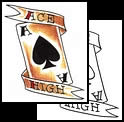 In the earliest card games, the King always took the highest value
(10), and the Ace the lowest (1). But as early as the 14th century,
the Ace could be played as the highest card, making the deuce the
lowest. During the French Revolution, the game 'Ace High' became
symbolic of the 'lowest classes rising above the aristocracy'. In the earliest card games, the King always took the highest value
(10), and the Ace the lowest (1). But as early as the 14th century,
the Ace could be played as the highest card, making the deuce the
lowest. During the French Revolution, the game 'Ace High' became
symbolic of the 'lowest classes rising above the aristocracy'.
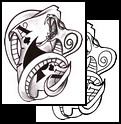 What
is so special about the Ace of Spades? Depending upon where you live
in the world, the different suits of cards have different rankings,
but in nearly all instances Spades are the highest ranking suit,
whether you are playing Poker, Bridge or a game of Chinese Big Two
or Choi Dai Di. The suits may be ranked either by alternating
colour, Diamonds (lowest), followed by Clubs, Hearts, and Spades
(highest), or alphabetically, Clubs (lowest), followed by Diamonds,
Hearts, and Spades (once again the highest). And as the Ace is the
highest ranking card, hence the Ace of Spades is the single most
powerful playing card in a deck of cards. What
is so special about the Ace of Spades? Depending upon where you live
in the world, the different suits of cards have different rankings,
but in nearly all instances Spades are the highest ranking suit,
whether you are playing Poker, Bridge or a game of Chinese Big Two
or Choi Dai Di. The suits may be ranked either by alternating
colour, Diamonds (lowest), followed by Clubs, Hearts, and Spades
(highest), or alphabetically, Clubs (lowest), followed by Diamonds,
Hearts, and Spades (once again the highest). And as the Ace is the
highest ranking card, hence the Ace of Spades is the single most
powerful playing card in a deck of cards.
 The short-tempered Queen of Hearts was made famous in Lewis
Carroll's
Alice in Wonderland, reputed to be a caricature of Queen Victoria.
"Off with their heads," shouted the Queen of Hearts as a solution to
anyone who crossed her path. In the book, she is the symbol of the
obstacles Alice will face on her journey through Wonderland. The short-tempered Queen of Hearts was made famous in Lewis
Carroll's
Alice in Wonderland, reputed to be a caricature of Queen Victoria.
"Off with their heads," shouted the Queen of Hearts as a solution to
anyone who crossed her path. In the book, she is the symbol of the
obstacles Alice will face on her journey through Wonderland.
'One Eyed Jack' refers to the Jack of Spades or the Jack of Hearts,
both portrayed in profile with only one eye visible from that
perspective.
'Joker's wild' or 'Deuces wild' is a designation by the dealer that
Jokers or deuces (2s) may be played as any card the holder desires.
Those most proud of their skills in card games, particularly in
poker, tend to frown on the inclusion of the 'wild' card, relegating
its use to amateurs. In fact, any card can be proclaimed wild before
the cards are dealt and an agreement has been reached between all
the players.
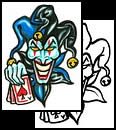 There were times when a card player might be caught with a deck
during a gambling prohibition. He might have defended himself by
claiming the cards had religious, metaphysical, or astronomical
significance, such as the four suits representing the four seasons,
the 13 cards symbolizing the 13 phases of the moon, the 52 cards of
the deck symbolizing the weeks of the year, etc. In fact, adding up
the numerical value of each card - and adding 1 (for the joker) -
you get the number of days in a year. Toss in the other joker and
you have a leap year. What! Me gambling? Never!!! There were times when a card player might be caught with a deck
during a gambling prohibition. He might have defended himself by
claiming the cards had religious, metaphysical, or astronomical
significance, such as the four suits representing the four seasons,
the 13 cards symbolizing the 13 phases of the moon, the 52 cards of
the deck symbolizing the weeks of the year, etc. In fact, adding up
the numerical value of each card - and adding 1 (for the joker) -
you get the number of days in a year. Toss in the other joker and
you have a leap year. What! Me gambling? Never!!!
The Joker is actually a relative new-comer to the card pack,
although it was familiar to users of the medieval Tarot deck as the
Jester or Fool. There are two to the standard pack, one red, one
black. It is commonly believed that the Joker was introduced by
Mississippi riverboat gamblers in the 1860s to serve as an extra
trump card. The red Joker outranks the black in games where
comparative values matter. In poker, the Joker is wild, representing
any card the holder desires.
 Wild Bill Hickok, historical gambler and gunslinger, died while
staring at a fistful of playing cards. He was shot dead while
playing poker in Deadwood, Dakota in 1876. The hand he was holding
-- two pairs, black Aces and black eights - came to be known as the
'dead man's hand'. According to legend, the fifth card hadn't yet
been dealt. Bill's hand can shows up as a favoured tattoo motif,
often located on the calf. Wild Bill Hickok, historical gambler and gunslinger, died while
staring at a fistful of playing cards. He was shot dead while
playing poker in Deadwood, Dakota in 1876. The hand he was holding
-- two pairs, black Aces and black eights - came to be known as the
'dead man's hand'. According to legend, the fifth card hadn't yet
been dealt. Bill's hand can shows up as a favoured tattoo motif,
often located on the calf.
Playing card tattoo designs are often symbols or amulets of luck.
And all of us could use a little good luck. Playing card tattoo
designs may feature a number of different cards, perhaps a winning
Poker hand like four Aces or a Royal Flush or they may feature a
single card which has special significance like the Queen of Hearts,
Joker or Ace of Spades. Card games, by their very nature, tend to
rely as much on luck as on the skill of the card player. Of course
that has never stopped a daring few from trying to make a living as
professional gamblers, also known as 'card sharps'. And judging from
the growing popularity of games such as Poker, many of us identify
with gamblers and the ability to make your own luck.
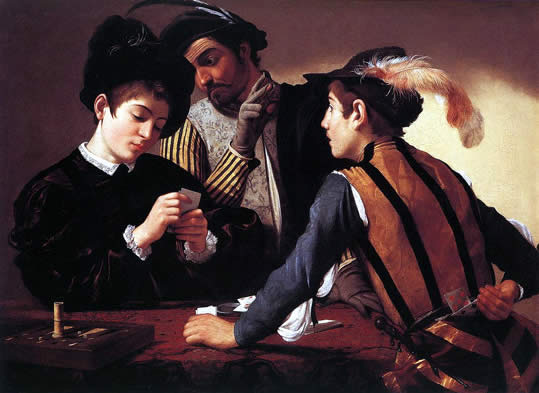
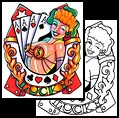 Playing
cards are also often featured in tattoo designs that warn of the
perils of gambling, such as in 'Man's Ruin'. Man's Ruin designs
feature the vices that can lean a man astray in life, such as women
of easy virtue, alcohol, drugs, and gambling - which may be
represented by billiard balls, pool cues, dice, playing cards and
perhaps even a horseshoe as a symbol of betting on the horses at the
track. Playing
cards are also often featured in tattoo designs that warn of the
perils of gambling, such as in 'Man's Ruin'. Man's Ruin designs
feature the vices that can lean a man astray in life, such as women
of easy virtue, alcohol, drugs, and gambling - which may be
represented by billiard balls, pool cues, dice, playing cards and
perhaps even a horseshoe as a symbol of betting on the horses at the
track.
 As tattoo designs, playing cards are a metaphor for life. As players
we can no more determine or predict the cards that will turn up in a
deck of cards than we can predict the future in a capricious
universe. Sometimes in life, as in games of chance, it is more
important to be lucky than to be talented. Having a winning hand
tattooed on your body may be just the luck you need to make the
difference between winning and losing! As tattoo designs, playing cards are a metaphor for life. As players
we can no more determine or predict the cards that will turn up in a
deck of cards than we can predict the future in a capricious
universe. Sometimes in life, as in games of chance, it is more
important to be lucky than to be talented. Having a winning hand
tattooed on your body may be just the luck you need to make the
difference between winning and losing!
Get
inspired by some great images and photos in our
Playing Cards Inspiration Gallery
See also: Lucky Tattoo Index
Choose your own playing card tattoo design from Tattoo-Art.com.
Find and buy the playing cards tattoo design that is perfect for you.
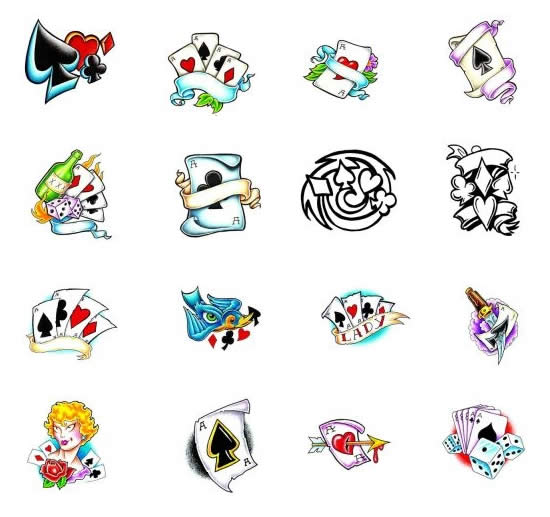
Pick out your own tattoo from all these Playing Card Tattoos and Designs at TattooJohnny.com

Tattoo designs - P >>
Playing Cards
Tattoo Symbol Index -
A
B
C
D
E
F
G
H
I
J
K
L
M
N
O
P
Q
R
S
T
U
V
W
X
Y
Z
|














